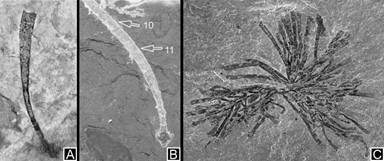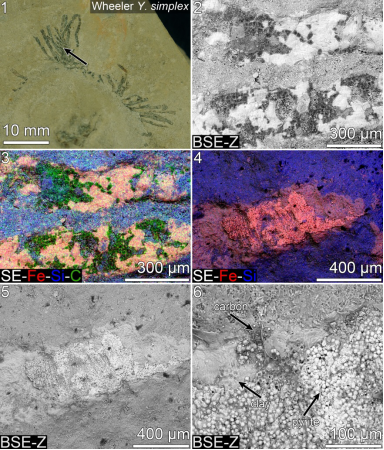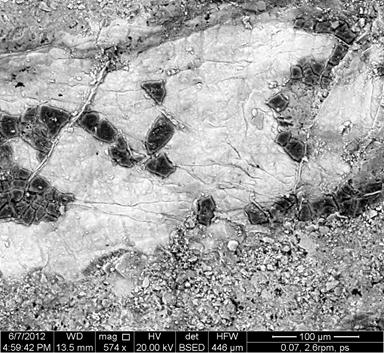Reports: DNI853833-DNI8: Organic Carbon Preservation in Deep-Time: Exceptional Glimpses from Exceptionally-Preserved Fossils and Laboratory-Based Decay Experimentation
James D. Schiffbauer, PhD, University of Missouri
The central theme of this PRF DNI supported research is to examine a well-known fossil preservational (taphonomic) pathway, Burgess Shale-type preservation. This taphonomic window occurs temporally around arguably one Earth’s most intriguing evolutionary intervals, the Ediacaran–Cambrian transition, ~635–485 Ma (Mega anna), where it reveals exceptional glimpses of the first major diversification of animals—the Cambrian Explosion. Burgess Shale-type preservation captures labile soft-tissues of non-mineralizing organisms predominantly as carbonaceous compressions, though associated with pyritization and aluminosilicification. Each case of soft-tissue preservation may be viewed as a race between destructive and constructive processes; that is, in order for labile tissues to be preserved, their typically easily degradable carbon framework must be stabilized through processes such as replacive mineralization or geopolymerization in order to survive the rigors of geological time and alteration. In addition to early animals, this preservational pathway also preserves abundant macroalgae during this time interval (Fig. 1). Macroalgae are largely underrepresented in terms of taphonomic research, but possess several promising characteristics that may help to better evaluate the micro-scale processes involved in carbonaceous compression preservation, including available modern analogs, histological homogeneity, and in many cases fine morphological and structural features. In the broadest sense, generally similar in focus to understanding the formation of petroleum or other carbon-bearing resources, the overarching goal of this research effort is to evaluate the diagenetic, biological, and paleoenvironmental factors responsible for preserving soft-tissues as carbonaceous materials. We use a combined approach of investigating Ediacaran–Cambrian macroalgal fossils in conjunction with mimicking paleoenvironmental conditions in laboratory-and-field-based experimental decay settings—while seeking to also investigate the fidelity of biological features as preserved by this pathway.
1. Fossil materials—
Last period, this grant supported field- and collections-based sampling of Ediacaran–Cambrian fossil materials, along with scanning electron microscopy-based microchemical analyses—with numerous successes to report. First, and perhaps most notable, from initial investigation of this material, it is revealed that not all of the fossils initially targeted represent macroalgae. Indeed, Yuknessia simplex, widely regarded as a green alga, has been reinterpreted by the PI and colleagues as a colonial pterobranch based on microscale features resembling hemichordate fusellar structures. These structures are not preserved by either carbonaceous compression or pyritization, but rather are only visible in aluminosilicified fossil materials (Figs. 2 and 3), suggesting an early taphonomic origin of this associated mineralization. This finding not only changes the current understanding of this fossil and places a deeper evolutionary origin on colonial pterobranchs, but also provides new evidence to an on-going debate in the literature as to the timing of aluminosilicification (manuscript in preparation), whether early in the taphonomic sequence (favored here) or possibly through later metamorphism. We additionally report the first observed North American occurrence of a macroalgal taxon known previously only from China (manuscript in press, TOC image). These findings have been presented at three conferences by the PI and collaborators, and directly address the research goal of better understanding biological expression of the fossil materials in question.
We have additionally conducted comparative microchemical analyses on animal fossils preserved through the same taphonomic pathways in the same localities. Comparative analyses of Cambrian arthropods and vermiform fossils, all from Cambrian strata of the House Range, southwestern US, have yielded four graduate student presentations at conferences by the two project-supported student researchers, and two manuscripts in preparation. From the arthropod studies, which comprised the majority of a Master’s student thesis, we have begun to parse out the relative timing of the associated mineralization pathways as based on association of taphonomies specifically with differing tissue labilities and/or surface-area to volume ratio of the preserved anatomical features. A prime contribution of this work is the observation of pyritization occurring on both labile and robust anatomical structures (Fig. 4), as opposed to previous inferences of pyritization preferentially associated with the most labile anatomies. Furthermore, this work has identified different clay mineralogies in association with different anatomical structures, which may ultimately relate to underlying tissue histologies. From the vermiform fossils, which are less compositionally heterogeneous as compared to the arthropods, carbonaceous compression is seemingly the dominant mode of preservation, potentially owing to the infaunal life habit of these organisms if clay mineral templating is detritally derived. This research is a major component of a PhD student dissertation.
2. Laboratory- and field-based decay experimentation—
This grant has additionally supported the operation and maintenance of an anoxic glove-box, in which modern analogs of the analyzed fossil materials are currently undergoing decay experiments to observe early stages of tissue stabilization (or degradation). Although impossible to replicate geologic time, this protocol allows for actualistic observation of the pace of decay under conditions designed to mimic the Cambrian seafloor where their fossil counterparts were preserved. At present, we are conducting decay experiments on macroalgae, polychaete worms, and crustaceans for this purpose. In addition, the MS student in the PI’s laboratory conducted a month-and-a-half-long decay experiment using crustaceans in a natural coastal environment, San Salvador, Bahamas, to supplement the laboratory-based decay experiments. We are only just beginning to assess the data from these experimental approaches, but are confident that our results will contribute to our understanding of the earliest stages of soft-tissue preservation.
3. Summary—
We have made several strides in fossil material analyses, which have yielded significant data and contributions to our understanding of Burgess Shale-type preservation, and have begun to assimilate results of decay experimentation to best-approximate the earliest stages of this taphonomic window. This Doctoral New Investigator Grant has allowed the PI and his laboratory to collect integral data contributing to a highly debated preservational pathway, and the results obtained thus far, and foundations built for future endeavors, will undoubtedly help in procuring long-term research funding.
Figure 1: Ediacaran–Cambrian “macroalgal” fossil examples; C = reinterpreted pterobranch Yuknessia simplex.
Figure 2: SEM analyses of Y. simplex.
Figure 3: Fusellar structure on Y. simplex fossil.
Figure 4: SEM analyses of Cambrian arthropod fossil.















